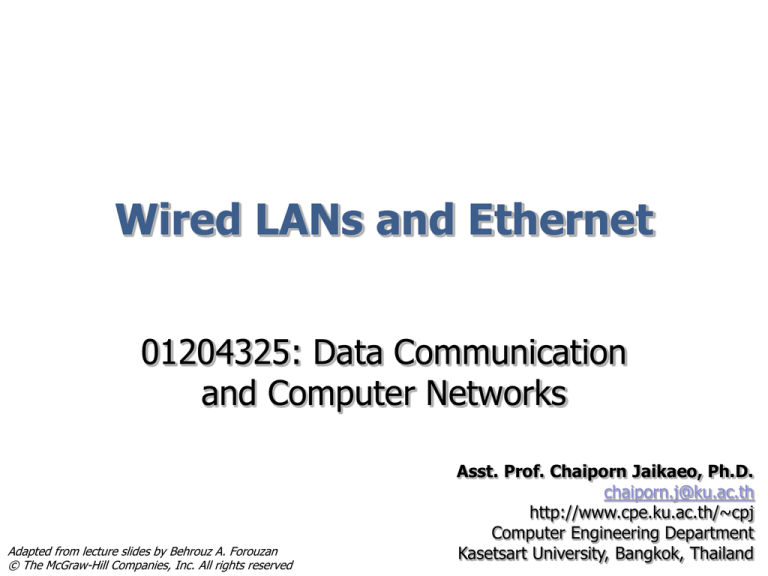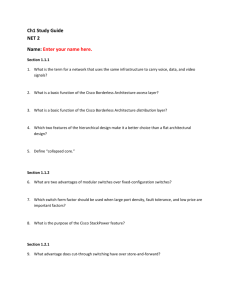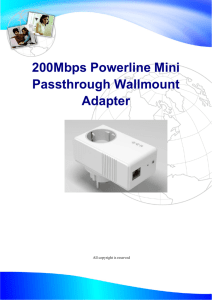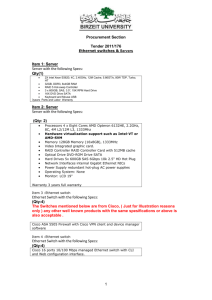
Wired LANs and Ethernet
01204325: Data Communication
and Computer Networks
Adapted from lecture slides by Behrouz A. Forouzan
© The McGraw-Hill Companies, Inc. All rights reserved
Asst. Prof. Chaiporn Jaikaeo, Ph.D.
chaiporn.j@ku.ac.th
http://www.cpe.ku.ac.th/~cpj
Computer Engineering Department
Kasetsart University, Bangkok, Thailand
Outline
IEEE standards for LAN/MAN/WAN
Traditional Ethernet
Unicast and multicast addresses
Fast Ethernet
Gigabit Ethernet
Ten-Gigabit Ethernet
2
IEEE Standards
Project 802
standards for enabling intercommunication
among equipment from a variety of
manufacturers
E.g.,
IEEE 802.3 Ethernet
IEEE 802.11 Wireless LAN (Wi-Fi)
IEEE 802.15 Wireless PAN (Bluetooth, etc)
http://en.wikipedia.org/wiki/IEEE_802
3
IEEE Standards for LANs
4
Logical Link Control Sublayer
Provides flow and error control for upper
layer protocols
Most upper layer protocols (such as IP) do
not require such services
DSAP – Destination Service
Access Point
SSAP – Source Service
Access Point
(Similar to TCP/IP ports)
5
Wired Ethernet
"Traditional" or "Original" Ethernet created
at Xerox's Palo Alto Research Center
(PARC) in 1976
Ethernet standards are set by IEEE 802.3
working group
6
Evolution of Ethernet
Ethernet Evolution
Standard
Ethernet
(10 Mbps)
Fast
Ethernet
(100 Mbps)
Gigabit
Ethernet
Ten-Gigabit
Ethernet
100-Gigabit
Ethernet
7
IEEE 802.3 MAC Frame
8
Min and Max Frame Length
9
Ethernet Addresses
48 bits (6 bytes) in length
Uniquely assigned to each Ethernet
network interface card (NIC)
Usually written in hexadecimal notation
E.g.,
10
Unicast vs. Multicast Addresses
A unicast address defines one recipient
A multicast address defines a group of recipients
The broadcast address defines a group of all
stations in the same LAN
A special case of multicast addresses
All bits are 1s
11
Example
Define the type of the following
destination addresses:
4A:30:10:21:10:1A
47:20:1B:2E:08:EE
FF:FF:FF:FF:FF:FF
12
Standard Ethernet
Categories of Standard Ethernet
14
Encoding in Standard Ethernet
15
10Base5 Implementation
16
10Base2 Implementation
17
10Base-T Implementation
CAT3 Cable
18
10Base-F Implementation
19
Standard Ethernet Summary
20
Raising the Bandwidth
21
Bridged Ethernet
A bridge divides a network into two or
more segments
Each segment is independent of one
another, bandwidth-wise
22
Collision Domain
Bridges help split collision domain into smaller
ones
23
Switched Ethernet
24
Full-Duplex Ethernet
25
Fast Ethernet
Fast Ethernet
Data rate: 100 Mbps
Standard IEEE 802.3u
Backward-compatible with Standard
Ethernet
27
Fast Ethernet Topologies
28
Fast Ethernet Implementations
29
Encoding for 100Base-TX
30
Encoding for 100Base-FX
31
Encoding for 100Base-T4
32
Fast Ethernet Summary
33
Gigabit Ethernet
Gigabit Ethernet
1000 Mbps
Standard IEEE 802.3z, 802.3ab
35
Gigabit Ethernet Encoding
36
4D-PAM5 Encoding
Used in 1000Base-T
37
Gigabit Ethernet Summary
38
10-Gigabit and Up
IEEE Standards
802.3ae 10GbE over fiber
802.3ak 10GbE over twin axial cable
(10GBASE-CX4)
802.3an 10GbE over UTP (10GBASE-T)
802.3ba 40GbE and 100GbE
39





